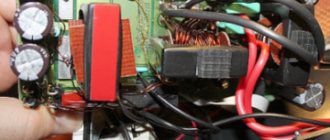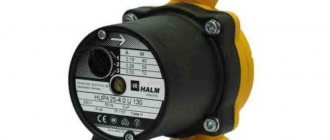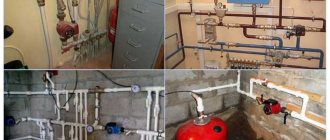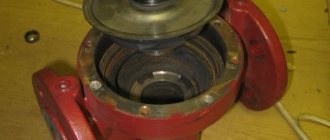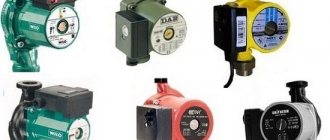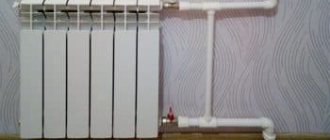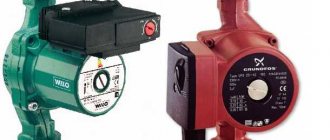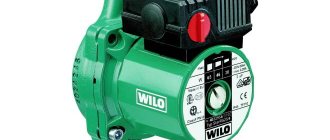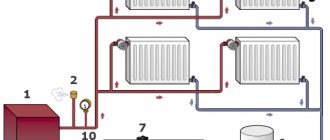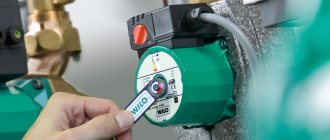To ensure that the heating system works reliably and does not fail due to power outages, it is worth purchasing a UPS for the heating pump. It will not only ensure constant operation of heating equipment, but will also prevent breakdowns caused by power outages.
In our country, in rural areas, and in many cities, power outages for several hours are a common occurrence. If the heating or heated floors are powered by electricity, then stopping the pump not only lowers the temperature in the house, but also creates the risk of a serious accident .
There are several solutions to this problem: installing a generator, changing the heating circuit so as to exclude the pump from it, purchasing an uninterruptible power supply.
A heating system without a pump will also require considerable costs. They include the costs of creating a project, purchasing larger pipes, and therefore expanding the passages for them.
The previous two steps are feasible, but there is a simple and cheaper solution for home and garden - purchasing an uninterruptible power supply .
Operating principle and design of the UPS
Every computer owner knows what an uninterruptible power supply is.
This device ensures the operation of the system when the central power supply is turned off.
Depending on the type, the uninterruptible power supply of the circulation pump performs the following functions:
- Transformation of direct voltage 12 V to alternating voltage 220 V.
- Switches automatically to battery power.
- Removing network interference.
- Voltage equalization.
The first three actions are provided by all models of uninterruptible power supplies, and the stabilization function is present only in certain varieties.
In practice, the following types of uninterruptible power supplies are used for emergency power supply of heating pumps:
- Spare.
- Linear interactive.
- Inverter.
Backup UPS
When using a backup uninterruptible power supply, when the electricity is turned on, the system is powered from the network, and if the electricity is turned off, the device switches the pump to battery power. The voltage from the battery is supplied to a transformer, which converts it into alternating voltage and increases it to 220 V. There is no voltage stabilizer in the device, and interference is eliminated using a passive filter.
The advantages of this type include the following:
- Characterized by high efficiency.
- Low noise, emit a small amount of heat.
- The most budget option.
Minuses:
- Switching takes a relatively long time.
- Distortion of the output voltage waveform.
- It is impossible to adjust the amplitude and frequency.
Line-Interactive
The main feature of an uninterruptible unit of this type is the presence in it of a simple stabilizer that equalizes the voltage. Such equipment is intended for devices that are characterized by increased requirements for the quality of power supply.
The operating principle is as follows: if the input voltage changes, the electronic switch is activated, connecting certain windings. As a result, the output voltage practically does not differ from the required one. The device is equipped with a voltage converter and a filter.
Advantages of this type of UPS:
- High efficiency.
- Doesn't make noise.
- Voltage equalization is carried out using an autoconverter.
Flaws:
- Long switching time.
- Low accuracy.
- Cheap varieties suffer from frequency deviations.
- Trapezoidal shape of the voltage curve.
Inverter
The device performs voltage conversion twice: alternating current is converted to direct current, and then again to alternating current, for which an inverse converter is used. If the power goes out, the equipment is powered by the battery, but no switching occurs since the battery is constantly connected to the circuit. On such devices you may see indications that the switching time is zero, but this is not entirely true, although no time is actually wasted. Therefore, such devices are also called On-Line UPS.
During periods of time when the voltage exceeds the rated voltage, capacitors store energy, later using it when the voltage drops.
All described actions occur under the control of a microcontroller, due to which voltage and frequency deviations are minimized.
Double inverting UPSs have significant advantages, which makes such devices more preferable than other options.
Their advantages include:
- Operate over a wide input voltage range.
- Ideal sine wave output voltage.
- Adjust voltage and frequency with high precision.
- There is no interference at the output.
Flaws:
- Noticeable fan noise.
- High price.
All uninterruptible power supplies for circulation pumps are equipped with a charger that recharges the battery.
What is an uninterruptible power supply?
An uninterruptible power supply is an electronic device that provides uninterruptible power to a heating pump. To do this, it contains a battery that stores electricity from the network. When the mains power is turned off, the uninterruptible power supply (UPS) almost instantly switches to operation from the battery (or from several batteries). This device consists of several main components:
Please note that not every uninterruptible power supply is a stabilizer - this is a separate option and may not be on board.
- Battery – accumulates electricity, and during a power outage, releases it to the load;
- Voltage converter – converts direct current with a voltage of 12 Volts into alternating current with a voltage of 220 Volts;
- Filter – filters out impulse noise in uninterruptible power supply systems with pulse converters;
- Stabilizer – ensures stabilization of the output voltage within the permissible error.
Also, all UPS have charge control circuits.
Features of choosing a UPS
In order for the device to ensure trouble-free operation of the heating system, it should be selected based on the parameters that will be described below.
UPS power calculation
The documentation for the pump for the heating system usually states the thermal power, measured in watts. There you can also find the value of cosine phi. To calculate the total power of the device, it is necessary to divide the thermal power indicator by the cosine ϕ, for example:
Power – 90 W, Cos ϕ – 0.6. Then the total power will be 90/0.6, that is, 150 W.
When starting the electric motor, it consumes three times more energy for a few seconds, so we multiply the resulting figure by 3 and get the required UPS power of 450 W. If you did not find the cosine ϕ in the documentation, then divide the value of the thermal power by 0.7.
Output signal curve . The output current curve must be sinusoidal in shape - with a curve in the form of a stepped sinusoid, meander or trapezoid, the load on the motor increases, which over time leads to its failure. For this reason, preference should be given to double conversion UPSs, but in some cases, backup uninterruptible power supplies are used for undemanding equipment. In the instructions for the inverter UPS you should look for the phrase “ pure sine ”.
The independent operation time of the UPS depends on the battery capacity. It is selected based on how long the electricity is usually cut off in your area. To be able to regulate this indicator, it is recommended to choose devices with an external connection of batteries: if necessary, you can connect or disconnect the required number of batteries.
Time to switch to autonomous power supply . It should be minimal to reduce the load on the heating system. For backup uninterruptible power supplies, the delay is about 4 ms, but this is enough to harm the heating boiler. For this reason, such UPSs are not used as heating boilers , but are sometimes used for circulation pumps.
Selecting a UPS configuration for a pump based on backup time
The choice of a specific uninterruptible power supply model for a pump depends on the electrical power of the pump and the required reserve time.
Considering that electric pumps have high reactivity, when choosing the power of an uninterruptible power supply for a pump, it is necessary to multiply the rated power of the pump by the load reactivity coefficient - 4. The exception is modern pumps equipped with standard starting devices that reduce the value of the starting current. In this case, the starting current value must be found in the technical data sheet of the pump.
How to connect a UPS
There are rarely any problems connecting modern UPSs. They are equipped with inputs and all the necessary wires; it is only important to follow the correct connection order.
The sequence of actions is as follows:
- Read the instructions carefully and check that all wires are present.
- If the design provides external power sources, connect them with wires to the device.
- Choose a place for the UPS: the device should be out of reach of children and animals, but close to the batteries.
- Connect the uninterruptible power supply to the pump, and if necessary, to a gas or solid fuel heating boiler.
- Connect the UPS to the network (there is no need to connect the batteries to the network) and check the operation of the equipment.
In order for the device to work correctly, you must follow certain rules when installing it:
- The temperature in the room must correspond to that specified in the instructions. Operating the device at high and low temperatures leads to a decrease in battery life.
- Installation of the ground loop should be carried out in accordance with the operating rules for electrical equipment.
- It is prohibited to install the UPS in places where there are vapors of flammable liquids and caustic substances.
Popular UPS models at reasonable prices
The main requirements for a UPS are the ability to operate in a wide voltage range and the presence of a smooth sine wave at the output. This imposes certain requirements on the selection of equipment.
But many manufacturers recommend using Russian-made UPSs, which are characterized by a relatively low price and good build quality. Models with a rated power of up to 600 W are suitable for boilers.
The approximate price of such equipment is 8–10 thousand rubles; it can power not only a boiler and a pump, but also other complex electronics.
TEPLOCOM-300
Price from 10,000 rubles. Power W/VA 200/300Advantages: 5-year warranty, the instructions include permission to use a car battery. Disadvantages: Inconvenient mounting to the wall, small input voltage variation
Inelt-Intelligent 500
Price from 6,500 rubles Power W/VA 300/500 Advantages: Operates quietly from the network. Good build quality. Switching is fast. Relatively inexpensive. Disadvantages: it heats up when running on battery power, the fan is weak and therefore noisy. Many people change on their own for a more powerful one.
Ecovolt-612C
Price from 9,500 rubles Power W/VA 600/800Advantages: Information display, wide input voltage range, there is an audible warning when the battery is low. Disadvantages: batteries must be connected to work as a stabilizer. It gets very hot.
IBPS-12-350K.2 on-Line
Price from 12,500 rubles Power W/VA 350/600Advantages: Automatic switching on when power is available, even if the battery is completely discharged.
Input voltage from 150 to 260V is very convenient in areas with large differences in input voltage. Disadvantages: 2-year warranty, could be extended to five years. A little more expensive than similar UPSs. It is inconvenient to connect to the network. Keep in mind that the indicated power of the UPS is the nominal value, but there is such a thing as starting power, which in a short time can exceed the average design load several times, therefore, you need to take into account the overload capacity of the UPS, and this is something you should ask a specialist about.
How to make an uninterruptible power supply with your own hands
It is quite possible to create an uninterruptible power supply yourself, but this requires theoretical knowledge. If you are not comfortable with electricity, then it is better not to take risks and not to endanger the heating system. Plus, a device created by yourself will not be ideal in terms of appearance, and will not work automatically, but using manual control.
To assemble the UPS, you will need:
- Converter 12 to 220 Volt. Inverters differ in their characteristics - you will need a device with an operating power of 300 W, and a peak power of 600 W.
- Batteries. It is best to stick with helium batteries; they are more expensive, but also last much longer.
- Battery charger. The power must correspond to the battery capacity.
Connect the plus and minus of the inverter with a wire to the plus and minus of the battery. Plug the boiler into the power supply at the inverter; after switching on, the device will start operating from the UPS. When the battery is discharged or the power is turned on, connect the charger to the battery.
It is important to understand not only how to make a UPS , but also how to ensure its reliable operation.
When assembling a homemade uninterruptible power supply, the following points should be taken into account:
- Use thick copper wires for connections.
- The wires should not come loose anywhere: carefully check that they are securely connected to the devices. The check must be repeated from time to time: if the metal in these places oxidizes, the reliability of the connection may suffer.
- Do not use car batteries.
- When batteries are connected in series, the voltage increases, but the capacity does not change.
- With a parallel connection, the capacitance increases, but the voltage remains the same.
- The minimum battery capacity for a UPS is 100 A/h, although on the Internet you can find uninterruptible power supply schemes using batteries of lower capacity.
Types of UPS
Connection diagram for a heated floor pump.
There are several types of uninterruptible power supplies.
A linear UPS is a representative of the simplest model of these devices. It does not have a voltage stabilizer. When disconnected from the mains, the device automatically connects to battery power.
Line-interactive UPSs are equipped with a simple voltage stabilizer. When connected to a battery, a pure sine wave is formed at the output, having parameters of 220V, 50 hertz.
The double conversion uninterruptible power supply has a voltage stabilization system and the ability to connect to a generator.
Line-interactive devices have lower internal voltage. From 1 to 4 batteries are enough to operate them. Such systems independently monitor the battery charge level. When the remaining capacity is 20%, the battery load is switched off. In the event of a power outage, the devices transfer power to batteries. When power supply from the main network is restored, all systems are connected to it.
To ensure uninterrupted operation of a non-volatile boiler, low-power CPS inverters with indexes 2000 EI, 1500 PIE, 1000 EI, 1000 E, 600 E are suitable. It is better to equip a non-volatile boiler with CPS inverters with indexes 7500 PRO, 5000 PRO, 3500 PRO.
Expert advice
When purchasing and connecting a UPS, you should consider the following recommendations:
- A power supply source is not something you should skimp on. By purchasing a high-quality device, albeit at a higher price, you will be sure that it will work for a long time and will not harm the heating system.
- If the uninterruptible power supply is intended to power a circulation pump , there is no need to connect a boiler and other equipment to it, because its power is not sufficient for this.
- It is recommended to buy UPSs designed to work with phase-independent devices.
- A good place to place a UPS is a semi-basement or basement, where the device will not occupy useful space. It is worth remembering that the equipment must be protected from moisture. To fulfill this condition, the UPS can be placed in a cabinet that is hermetically sealed.
No home is immune from power surges and power outages. For modern automated heating boilers and pumps, they are destructive.
If there is no electricity for a long time, this can lead to an accident in the boiler due to overheating.
Prudent owners install special equipment for this case - a UPS for the heating circulation pump. Let's figure out how it works, what types there are and how to make the right choice.
What are uninterruptible power supplies and why are they needed?
Modern heating boilers are controlled by a microcontroller that requires power supply. In addition, constant power to the pump motor is required.
If the control module can support functions from a small battery, or even temporarily turn off, the coolant circulation will stop.
Many boiler models independently control the pump: that is, its installation in a pipe with coolant is standard. From the point of view of the UPS, it does not matter how the system operates: synchronously, or the equipment turns on by itself.
Its task is to prevent loss of control of the boiler and pump when the main power supply is turned off.
Uninterruptible power supply units for heating pump
Externally, the device resembles a large system unit. Often the front panel has a display with a clock and a panel with buttons. Intuitive controls - all basic data is displayed on the screen: input and output voltage, battery charge level, current strength and others.
The essence of its work is to accumulate energy in batteries and then release it when necessary.
Connecting an uninterruptible power supply to the heating system
- uninterruptible power supply unit;
- 12 V battery(s).
The voltage of 220 V is converted to 12 V and supplied to the charger. At the same time, energy feeds the boiler from the network. When the battery(s) are fully charged, the current supply is automatically stopped, i.e. it continues to arrive, but in transit.
If the network is turned off, the UPS begins the reverse conversion - constant from 12 V batteries to alternating 220 V.
Operating principle of an uninterruptible power supply
The automation will automatically turn on the backup power supply, and when the power supply is restored, it will switch to operation from the network. No human intervention is required to charge the batteries. It works silently.
Most often, batteries made using AGM technology or with gel electrolyte are used. Connect them in series. All end bends and jumper cables are included.
There is one caveat - the UPS takes longer to charge than it discharges. Therefore, an uninterruptible power supply for a circulation pump will not be able to completely replace the power plant for a long time.
The need for a UPS
In addition to the situations already listed (power outages and power surges), a UPS is also useful when the energy source is an air-cooled generator - diesel or gasoline.
The voltage produced from it has a sawtooth output when a pure sine wave is required. A double conversion UPS installed between the boiler and the generator solves the problem.
So, here is a list of requirements for a UPS:
- voltage stabilization;
- possibility of long-term operation without external power supply;
- voltage supply in the form of a smooth sinusoid;
- frequency accuracy;
- smooth and instant transition to batteries;
- reliability.
Main types of uninterruptible power supplies
This type of UPS is equipped with a stabilization function and is divided into subclasses:
Linear
UPS operating on the Bypass system. The input voltage is immediately converted to DC using a rectifier. Then, having a backup battery pack at the input, the inverse converter is switched on (see illustration).
The output voltage parameters are always stable; the backup system does not seem to notice the voltage drop. The main advantage is that such UPSs do not have the concept of “switching time to backup power.” It is always there.
Disadvantages: relatively low efficiency (double conversion losses, which are always present) and increased wear of batteries. In addition, such devices are relatively expensive.
Linear interactive
Uninterruptible power supplies are a compromise solution between inexpensive and inefficient backup circuits and inefficient linear ones.
Essentially, this is a two-in-one device. A voltage stabilizer is installed at the input (usually based on an autotransformer).
When its circuit cannot cope with the variation in parameters, or the input voltage is completely turned off, the interactive UPS switches the switch to a voltage converter powered by batteries.
This is the main drawback of the device: switching takes time, albeit small - a few milliseconds. This places additional stress on the pump motor and boiler controller circuitry.
Choice
The first thing to consider when choosing an uninterruptible power supply:
- Circulation pump power.
- Its energy consumption class.
- The time for which the lights are turned off.
Why do you need to know the energy consumption class? Let's say we have a 45 W pump. At the moment of startup, a power surge occurs, i.e. it will consume more watts. It is important that it does not exceed the capacity of the UPS. If you have a class A pump, the frequency converter reduces the starting torque to 1.5 times the normal power. Then the maximum power indicator will be 45x1.5=67 W.
If you do not know the energy consumption class of the pump, it is better to play it safe and take a factor of 6. Then the calculation will look like this: 45x6 = 270 W.
The operating time of the UPS will depend on the number and capacity of the batteries. However, increasing the number of batteries is not cheap and not all uninterruptible power supplies allow the use of additional battery packs.
UPSs with built-in batteries are used mostly to mitigate power surges - transforming their sawtooth shape into a smooth sine wave. In case of shutdown, they can ensure the operation of the boiler only for 20 minutes.
Another option is a UPS with a charger to which you can connect external batteries.
Battery life is calculated as follows:
(Battery capacity) x (per circuit voltage) : (total power in VA)
Note: To convert the total power from W to VA, it must be divided by 0.7.
8-12 hours of battery life is a good indicator for a UPS. And for batteries, the optimal capacity is 100A/h.
Scheme of UPS operation using Offline technology
Line-interactive or Online UPS to choose?
If the boiler is gas or diesel, On-Line devices are better suited. You can also use Linear Interactive, but additionally install a voltage stabilizer to it.
For solid fuel boilers, you can choose a cheaper linear-interactive UPS.
Mistakes that are often made when choosing a UPS:
- The battery life is determined not by the power of the device, but by the capacity of the batteries.
- If the marking contains the LT index, this means that the UPS comes with external batteries, which are not included in the price of the unit. You need to buy them additionally - without them the device will not work.
- The numbers indicated in the model are not W, but VA.
- Refrain from purchasing UPS from dubious manufacturers.
Manufacturers that have proven themselves to be reliable are Fiamm, Leoch, Delta, AQQU, CSB, Inel.
Read about what vapor-drip heaters are and where they are used in this article.
Approximate prices
A linear-interactive UPS for heating can be purchased for 5800 – 9400 rubles.
The On-Line series model will cost from 12,300 rubles. There are units for 20, 33, 75 and 100 thousand rubles.
As already mentioned, batteries are not included with the UPS - they must be purchased separately.
Depending on the model and capacity, one battery can be purchased for 2300-11000 rubles.
Purchasing and installing a UPS may seem like a waste of time and money. However, there is a possibility of losing expensive equipment and being left without heating during the cold season. And if you weigh all the pros and cons, the costs of uninterruptible power supply no longer seem so great.
Factory models
You can buy an uninterruptible power supply suitable for its characteristics in heating and plumbing stores. They are also sold in online stores. Final prices vary depending on the manufacturer, type of equipment and technical specifications. We will look at the most popular models and give their estimated cost.
Energy PN-1000 with 75 A battery
We have a simple uninterruptible power supply with a good battery capacity of 75 A/h. With a pump power of 100 W, the battery life will be about 8 hours. The peak power is 1000 W, which is enough for any reactive load. At the output, the device produces a pure sine wave. And it refers to line-interactive UPSs, characterized by high efficiency and an affordable price.
The cost of the model on the domestic market is about 260,000 rubles. Modifications with different battery capacities are also available for sale:
- At 100 A/h – up to 11 hours when operating with a load of 100 W;
- At 55 A/h – up to 6 hours when operating with a load of 100 W;
- At 200 A/h - up to 23 hours when operating with a load of 100 W.
If power outages in your area are frequent and long-lasting, we recommend paying attention to the latest modification - its cost is 36-37 thousand rubles.
SVC DI-600-F-LCD
A compact uninterruptible power supply that can work with boilers and pumps, ensuring continuous circulation of coolant in the heating system. It belongs to the category of linear-interactive and produces a pure sine wave at the output without any distortion. The equipment does not require user intervention in its operation and provides an output voltage error of no more than 10% - this is the norm for pumps, but for boilers it could be less.
The speed of switching to operation from the battery does not exceed 20 ms. There is no built-in battery here; an external battery with a capacity of up to 200 A/h is connected to the uninterruptible power supply - this will ensure up to 24 hours of autonomous operation of the heating system. The peak load for this model should not exceed 360 W. The estimated cost of the model is 6.5-7 thousand rubles.
Tieber T-1000
If you need an uninterruptible power supply with a maximum capacity, from which the pump can operate for up to two days, you should look at this model.
It works with two batteries with a capacity of up to 200 A/h each. The manufacturer recommends using maintenance-free gel batteries, as they do not emit harmful gases into the atmosphere - this is important for residential premises. The maximum load power is 800 W. An uninterruptible power supply can power fairly powerful pumps and heating boilers, as well as units of water heated floors. The output voltage form is a pure sine wave, as required by pumping equipment motors. The device is designed for floor installation; batteries are placed next to it. The maximum charging current is 12 A/h.
Video on the topic
In country houses and cottages, one of the most important functions performed by household appliances is heating.
If you can still do without a TV and a computer, then in winter it is impossible to live in a private cottage without heating. Therefore, an uninterruptible power supply for the heating circulation pump must be connected to the heating system, which ensures the operation of the electronics of the heating boiler and, most importantly, the operation of the pump in case of mains voltage failures.
Connection diagram
Let's consider a diagram for connecting an uninterruptible power supply with two batteries. In this case, the batteries are connected in parallel, which will increase their total capacity. Let's calculate the operating time and cost of such a system.
Connection diagram of an uninterruptible power supply to the heating system
Note! With an increase in the number of batteries, their total capacity will increase and the operating time of the heating pump and additional devices that are connected to the UPS will increase.
As the power of connected devices increases, their operating time in offline mode will increase. The pump itself, when operating in standard mode, has a power of 50 watts, in which case two powerful batteries will ensure 50 hour operation of the device. If you connect another native consumer to the UPS, for example, a light bulb with a power of 100 watts, then their battery life will decrease to 18 hours. At a load of 500 watts per hour, two new charged batteries will completely lose their charge after 5 hours of operation.
Uninterruptible power supply with batteries
As for costs: an average-priced uninterruptible power supply will cost 17 thousand rubles, plus two batteries for 14 thousand rubles. We will get 31,000. For this money you can buy a gasoline electricity generator, but this requires additional expenses for gasoline and certain skills in working with the installation. Of course, a UPS can be bought cheaper; a gas generator is used here as an alternative option.
UPS for circulation pump
A heating system may have one or more circulation pumps. They ensure the movement of coolant through pipes and radiators. In this case, the coolant (water) ensures constant transfer of heat from the gas boiler to the radiators, and cooled water back to the heating system.
The circulation pump avoids water stagnation in the system, which can lead to a serious accident. Therefore, any heating system must be equipped with an emergency power source.
Types of UPS and the principle of their operation
According to their design and operating principle, emergency power supplies can be divided into the following groups:
- Backup power supplies;
- Linear interactive devices;
- Double conversion blocks.
Backup UPS
The backup power supply is one of the simplest devices. It consists of the following nodes:
- Passive network noise suppression filter;
- Accumulator battery;
- Inverter-converter;
- Monitoring and control board.
If the control board determines that the network voltage is normal, taking into account permissible deviations, then the consumer receives power directly from the network. As soon as the voltage deviation goes beyond the tolerance limits, the electronics switches the load to battery power.
The voltage removed from the battery is supplied to a simple inverter, where it is converted into 220 V. The mains voltage first passes through an inductive-capacitive filter, which allows you to block most of the pulsed high-frequency interference and single short voltage surges.
The shape of the current at the output of the backup source differs from a smooth sinusoid and has a stepped shape. Typically, heating systems use asynchronous electric motors, which require a smooth sine wave to operate correctly, so backup power supplies are not recommended for use in systems of autonomous gas boilers.
How to choose
When choosing a UPS for a heating system pump, you need to take into account a lot of nuances that will affect the final cost of the device. In this case, the following is taken into account:
- Number of phases. You can buy single-phase and three-phase models on the market, but only the first type is used in everyday life. Three-phase UPSs are designed for industrial needs;
- An important parameter is the power of the device, which is calculated based on the total power of connected consumers. In this case, the starting load of the equipment is taken into account, because it will be greater depending on the operating voltage. This characteristic can be found out from the pump passport; the load value is called “starting current”.
Note! When selecting a UPS for a pump, voltage drops in the electrical network are taken into account. If the increase or decrease in voltage is within 8-9%, then buy an uninterruptible power supply with an operating range of a voltage drop of 10% up or down.
IPB in the heating system
If you neglect this simple rule, then after a sharp jump or drop in voltage, the pump will run on battery power, which will quickly damage the UPS. It is advisable to purchase equipment with several useful functions.
For example, a cold start allows you to turn on the pump even when there is no power in the network. The device must have indicators indicating the battery charge level. A decrease in battery capacity to a critical point must be accompanied by a special sound signal.
Uninterruptible heating system Cyber Power CPS600E
In addition to all the listed nuances, it is necessary to pay special attention to the power of the pump. If you have installed a weak uninterruptible power supply, the built-in battery may not be enough for long-term uninterrupted operation of the system. According to experts, it is best to buy a device with an external battery connection, which will make it possible to select the required capacity of the pump’s backup power source.
Criteria for selecting a UPS for a pump
When choosing an emergency power source, you should be guided by certain technical characteristics:
- Power supply power;
- Battery capacity;
- Battery life;
- Possibility of installing additional batteries;
- Presence or absence of output signal distortion;
- Switching time to reserve.
UPS power and its calculation
This, by definition, is the main parameter that you should pay attention to when choosing an emergency power supply for a circulation pump. To correctly select the required power of the device, you must first calculate it using a simple formula. Since the circulation pump electric motor is a reactive load, it is calculated as follows.
The passport for the circulation pump usually indicates the power in watts. This is the so-called thermal power. An additional coefficient may also be indicated there, which is called Cos ϕ (cosine phi). To obtain the full power, you need to divide the thermal power by this value. If Cos ϕ is not specified, the value of 0.6 is taken for calculations.
At the moment of starting the electric motor, the current consumption sharply increases by about 3 times and this value should also be taken into account. Therefore, the final choice of UPS power will look like this:
P/Cosϕ*3
If the pump power according to the passport is 120 W, then the result will be:
120/0,6*3=600
An uninterruptible power supply for a heating circulation pump usually powers the electronics board of a gas boiler. The power there is small, and taking into account the small reserve, the required power of the emergency power source will be equal to 650-700 W.
Battery capacity
The time during which the heating system will operate when the network is turned off depends on the capacity of the battery. In terms of price/capacity ratio, 12 V batteries at 100 A/h will be the most optimal. In order to find out the operating time of the consumer from the battery, it is necessary to multiply the battery capacity by its voltage and divide by the load power.
For example, a pump with a total power of 150 watts will work:
100*12/150=8 hours.
Some UPSs for the heating circulation pump allow the connection of additional external batteries, which can increase the operating time in emergency mode several times. Of all emergency power supplies, only double voltage conversion devices can produce an ideal sine wave output. Among the expensive line-interactive units, you can also choose a UPS with similar characteristics, but the switching time to reserve for such sources is much longer than for inverter devices.
Installation of emergency power supply
In order for the backup power source to work for a long time and without accidents, you should follow some simple but quite effective rules:
- The temperature should be in the range of + 18-25 degrees;
- There should be no dust or vapors of aggressive liquids in the room;
- The power supply housing must be grounded;
- A rubber mat should be placed under the floor block;
- Do not cover the UPS with anything;
- Do not confuse battery polarity.
At lower temperatures, the UPS for the circulation pump will, of course, work, but the battery life will decrease.
Rating of the best models
Now let's take a look at the most popular UPS models for circulation pumps and heating boilers. The rating of devices is based on popularity.
| Place | Appearance | Brand/Model | Type | Power, W nom./max. | Input voltage range, V | Battery capacity, Ah | Peculiarities | price, rub. |
| 1 | UPS Energy PN-500 45/75Ah Buy | linear interactive | 300 / 500 | 145 … 265 | 45, 60 or 75 (optional) | “cold start”, charging current 8 A, forced ventilation only during active operation | 14 500 | |
| 2 | Hiden HPS20-0312+45ah Buy | linear interactive | 300/400 | 140 … 275 | 45 | “cold start”, charging current 8 A | 13 000 | |
| 3 | Calm +18ah Buy | double conversion | 350/420 | 90 … 300 | 2 x 18 (built-in) | ECO mode (linear interactive), charging current 3 A, compact wall design | 25 600 | |
| 4 | East Home 300w +30ah Buy | linear interactive | 250 / 300 | customizable | 30 | wall-mounted design, input voltage range adjustable, charging current 1A | 14 700 | |
| 5 | Stark Country 1000 LI +100ah Buy | linear interactive | 450 / 600 | 140 … 290 | 100 | “cold start”, charging current 10 A, forced ventilation only during active operation | 25 200 | |
| 6 | CyberPower SMP550EI+38ah Buy | reserve (Off-Line); | 200 / 300 |
| 38 | charging current 3 A, silent operation | 13 908 |
UPS technology
Uninterruptible systems that continuously send the power required to connect equipment through a rectifier and inverter are known as double conversion uninterruptible power supplies.
Such devices convert alternating current to direct current and then convert the direct current back to alternating current to power connected equipment. This method effectively protects the AC network by filtering out line noise and other anomalies. An additional advantage of this technology is the continuous operation of the equipment.
Technological improvements have resulted in significant increases in efficiency, giving this technology some advantages over other types of devices.
UPS diagram
Which battery to choose
As already mentioned, UPS batteries require special batteries, not car batteries. There are two types of batteries for uninterruptible power supply systems:
- Helium.
- And AGM, fiberglass.
Both options release charge slowly and withstand many charge-discharge cycles.
Gel batteries:
- Developed for military aircraft.
- The electrolyte contains silicon, which makes it thick, like jelly.
- The battery can be turned over, and even with a broken case, the electrolyte does not leak out.
- Guaranteed up to 600 recharge cycles.
- Does not require supervision or maintenance.
- More expensive than AGM.
Minus of gel batteries. When boiling, air bubbles form in the electrolytic gel, and this can cause an explosion.
AGM battery Sprinter
Fiberglass (AGM):
- Safer batteries developed after gel batteries.
- Between the lead plates there are fiberglass inserts impregnated with electrolyte.
- Guaranteed up to 300 recharge cycles.
- A person needs to periodically check the electrolyte level and, when necessary, refill the battery.
- AGMs are not afraid of excess charge, they are less whimsical.
- Prices for AGM are lower than for helium.
The German brand Vilo was born many years ago and has gained a positive reputation around the world. Wilo pumps: technical specifications and model overview, read on.
How to make a heat pump for heating a house with your own hands, read here. Advantages and disadvantages of technology.
For types of circulation pumps for heating, see this link: https://microklimat.pro/otopitelnoe-oborudovanie/otopitelnye-pribory/cirkulyacionnyj-nasos-kak-vybrat.html. The topic contains a lot of useful information about choosing a device.
Battery capacity
Batteries are almost always sold separately from the UPS. They have different capacities and the user can choose 1 or several batteries to suit his needs. The higher the total capacity of all batteries, the longer the equipment will be able to operate during a blackout at home.
And here there cannot be a one-size-fits-all solution. If power outages do not happen often in your area, a few hours of backup power will be enough, which will be enough for electricians to eliminate the accident on the site.
Usually, the documents for the battery indicate the estimated battery life under different loads.
Exide Gel Battery
Example. Pump power – 250 W. The operating voltage of the battery is 12 V. To find out the current with which the battery will operate, you need to divide the power by the voltage: 250: 12 = 20.9 A. Capacity is measured in Ah.
That is, to find out which battery will provide our pump with uninterrupted operation for two hours, you need 20.9 x 2 = 41.8 Ah. You can purchase a battery with a value closest to this indicator. For example, 50 Ah (we take into account that over time, the battery capacity decreases, so we take it with a reserve).
Types of UPS
There are three types of devices.
Spare
The emergency power supply supplies the system with electricity from the mains. If problems occur with the latter, the device switches to battery power .
The DC voltage from the latter enters the converter, where it slowly changes to AC. The value gradually increases from nominal to 220.
The filter blocks impulse noise that interferes with stable operation.
The backup source has three advantages over analogues:
- The efficiency is about 95% , sometimes higher.
- Quiet operation, low heat release to the environment.
- Cheapness of the device.
But there are also disadvantages:
- Long switchover after loss of direct power.
- Voltage distortion .
- There is no way to adjust the amplitude or frequency.
Interactive uninterruptible power supply
Also known as linear. It has one difference from the backup one: instead of a converter, a stabilizer .
Its circuit contains an automatic transformer that uses different windings when the voltage at the input to the device changes.
This helps to achieve an output that is almost identical to the initial output. The system is more advanced in terms of operation, but also includes a converter and filter.
Advantages of interactive UPS:
- Efficiency up to 95%.
- Quiet operation.
- Application of an automatic transformer.
The disadvantages include:
- takes a long time to turn on during a power failure.
- Low accuracy of the device.
- that is far from sinusoidal .
- Frequency deviations in low-quality models.
Double conversion UPS with external battery connection
This design is significantly different from the previous ones. An inverter uninterruptible power supply rectifies the voltage, storing energy in capacitors.
Photo 1. Uninterruptible power supply model Smart 312 for circulation pump, power 300 W, .
The second part of the device repeats the conversion, converting direct current into alternating current. Batteries containing charge begin to give it away when there is a sudden voltage surge. The process is controlled by a microcontroller with a built-in generator. The latter is usually made from quartz . This increases the accuracy of the device and stabilizes the frequency.
Important! Double inversion helps to obtain a sinusoidal indicator , which is very important for long-term operation.
The UPS must also include a battery , which is charged when powered by the utility. A design with a detachable battery is acceptable. In this case, the latter is filled separately, and the uninterruptible power supply simply passes the current.
Sources of this type have the following advantages:
- The device is capable of operating in a wide range of values , converting voltage.
- Greater accuracy while stabilizing performance.
- Fast switching on when mains power is lost.
- Coincidence with the pump operating frequency.
- No interference despite no filter.
- The voltage shape is close to ideal .
Disadvantages: high cost and loud fan noise
UPS operating principle
As mentioned above, a UPS is a complex device. Its operating principle is based on the fact that with a constant flow of electricity, it simply equalizes the voltage (in the presence of surges), and also clears it of impulse and electromagnetic interference. In other words, at this time the uninterruptible power supply provides the circulation pump with high-quality electricity. At the moment when the electricity suddenly turns off, the UPS turns on the inverter, which converts the current from the battery into alternating current and the pump runs from it.
When electricity appears again, the inverter turns off and the battery begins to charge, and the circulation pump operates directly from the network. The built-in stabilizer is designed not only to protect the device from voltage surges, but also to protect the battery. A surge filter is needed to clean the current from pulsed and electromagnetic interference.
The advantages of a UPS for a heating circulation pump are obvious:
- protection of devices that depend on electrical energy from network interruptions, which increases the service life of the device;
- The UPS supplies the device with the best quality current;
- ensuring long-term battery life (about two days);
- high efficiency;
- quiet operation;
- ease of installation.
Which uninterruptible power supply should I choose for a heating pump?
All modern heating installations, be it a parapet boiler with a full set of automation, a solid fuel boiler with wood, a combined one, a fireplace with a heating circuit or an “AGV” with a circulation pump, all heating devices with a built-in circulation pump require an uninterrupted power supply of 220 volts. Otherwise, if emergency situations occur in winter, when the lights are turned off for several hours to a day, the heating radiators may remain cold, and in a country house or dacha, if the coolant is not “antifreeze,” they may completely freeze and “crack” when freezing. Likewise, chimney fireplaces with a built-in heat exchanger require uninterrupted circulation of the coolant, otherwise water boiling in the fireplace can damage any section of the house’s heat supply line.
An inverter or voltage converter (UPS) is a special device designed to convert the direct voltage of a battery or energy-generating device (solar panel, wind generator, etc.) into an alternating voltage of 220 volts.
To power most pumps (and motors), there is one very significant requirement for inverters - the current frequency must be 50 hertz, and its built-in generator must produce alternating voltage of an ideal shape, close to a sine wave (as it is in a 220 volt outlet)
A converter supplemented with a battery (several batteries) or with a battery built into the case is called a UPS (uninterruptible power supply) or simply speaking, an uninterruptible power supply.
But do not confuse the uninterruptible power supply of a computer, TV or other similar household appliances with the uninterruptible power supply of a heating boiler. The difference is that if the computer, or rather its switching power supply, does not care what frequency the voltage is and what shape it has, then it is important for heating boilers, or rather their automation and especially circulation pumps (like all electric motors), to be powered by a stable voltage of 220 volts, 50 hertz sine waveform.
In addition to the heating system, such a converter is needed for the uninterrupted operation of an electric water supply pump that pumps water into the house from a well or well; it is needed for drainage (sewage) systems, grinding systems in kitchen sinks, refrigerators and compressor equipment. It is not needed except for the operation of a boiler, TV, computer, chargers and the like, but it will not be superfluous and the power from such a converter will extend the service life of any device, since, unlike cheap (computer) UPSs, the voltage in shape and stability is not different from the network one, and sometimes even better in terms of stability.

